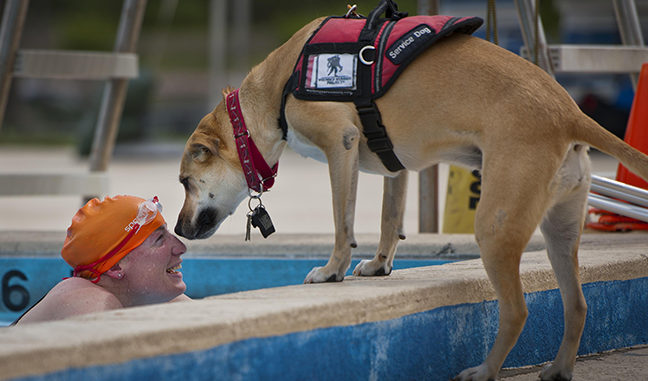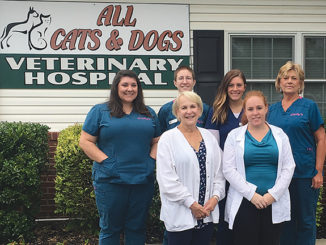
 One of the most amazing parts of being a steward in the animal industry is being witness to the incredible talents of pets. While stories of extreme acts of heroism by cats and dogs are usually given front page honors, I’ve always felt that the quiet valor of service dogs is something to be applauded. What is more remarkable than dogs that are able to sense the smallest chemical shift in a diabetic’s sugar levels in order to alert their owner to a possible hyper- or hypoglycemic episode? Or the uncanny ability a service dog has to be the eyes and ears for visually impaired and hearing-impaired persons? These dogs are more than just pets. They are companions and life-lines to a world that isn’t always very kind towards physical and emotional impairments.
One of the most amazing parts of being a steward in the animal industry is being witness to the incredible talents of pets. While stories of extreme acts of heroism by cats and dogs are usually given front page honors, I’ve always felt that the quiet valor of service dogs is something to be applauded. What is more remarkable than dogs that are able to sense the smallest chemical shift in a diabetic’s sugar levels in order to alert their owner to a possible hyper- or hypoglycemic episode? Or the uncanny ability a service dog has to be the eyes and ears for visually impaired and hearing-impaired persons? These dogs are more than just pets. They are companions and life-lines to a world that isn’t always very kind towards physical and emotional impairments.
Service dogs and their boundaries are governed by the Americans with Disabilities Act in conjunction with Department of Justice. Under the original terms of the ADA, “… a service animal is defined as a dog that has been individually trained to do work or perform tasks for an individual with a disability.” More recently, the ADA has also included a provision that allows miniature horses to serve as service animals for people with disabilities, but for the sake of this article we will only be looking at service dogs and their contributions to the disabled community.
While the ADA specifies that service dogs do not have to be professionally trained (although many do come from training organizations), the service dog must be trained before it is allowed in public places, so the ADA does allow for the service dog to be trained by their handler. It is important that the dog be trained because a service dog, under the ADA, must be “…under control of the handler at all times,” which means they shouldn’t bark (unless it is a warning to their handler or if they are provoked), they shouldn’t wander off, show signs of aggression or anxiety, and they must be housebroken. Additionally, according to the ADA, “…if a particular service animal behaves in a way that poses a direct threat to the health or safety of others, has a history of such behavior, or is not under the control of the handler, that animal may be excluded (from a public place).”
When a disabled person and their service dog enter a public establishment, the staff of that establishment is only allowed to ask two specific questions, according to the ADA: 1.) Is the dog a service animal required because of a disability? 2.) What work or task has the dog been trained to perform? Additionally, while many service dogs do wear vests or other paraphernalia that proclaim their service dog status this is not a requirement under the ADA. Furthermore, handlers are not required to produce or display any type of documentation that certifies their dog as a service dog. Unfortunately, this creates a loophole in which non-disabled people can freely tote their pets around restaurants and stores. In most cases, people claim that these house-pets are emotional support animals because many store owners and their staff are unaware of the difference and are legally unable to confront these people anyway.
The ADA does not recognize dogs that are coined as “emotional support animals” because, according to Canine Companions for Independence Training Manager Adele Moses, “…ESAs are not trained to perform a task, just their presence is what provides emotional support, which does not fit the ADA definition.” Because Moses trains service dogs she understands the unique complexities of their duties, but recently her dogs have been on the biting end of fake service dogs.
“We’ve had clients whose dogs have been attacked by other dogs in public,” Moses said. “If people don’t care to properly train their dogs, they may also not be keeping them properly vaccinated. Just their presence can be a distraction to the actual working dogs.”
As Moses explained, fake service dogs are usually not properly trained so they are unequipped to be in social settings causing them to bite/growl at business patrons and destroy property by urinating/defecating inappropriately. This can cause misunderstandings and frustrations between business owners and legitimate service dogs and their handlers.
Service dogs are, at their core, workers. Their one duty is to help their handler maintain a livelihood that they wouldn’t be able to otherwise. With this in mind, it’s essential that, as members of society, we give service dogs and their owners respect. Moses suggests asking permission before approaching or petting a service dog, but don’t be intimidated. Many service dog handlers enjoy answering questions about their service dogs. However, please keep in mind that service dogs are not present for the enjoyment of the public. They are a necessary lifeline for a person with a legitimate disability.
-by Jessica Mann
About the Author:
Jessica Mann has worked as the Client Care Specialist at All Cats & Dogs Veterinary Hospital since 2009. Most days you can find her behind the front desk fielding phone calls and cuddling puppies and kittens. She is a recent graduate of WKU with a degree in English literature.



